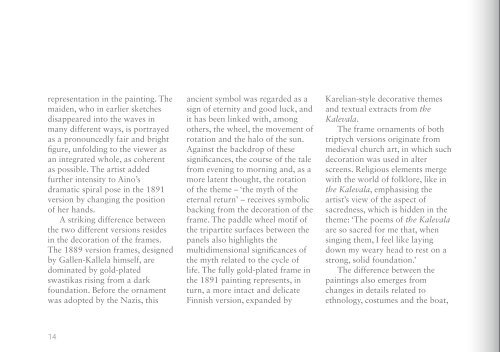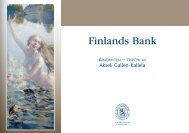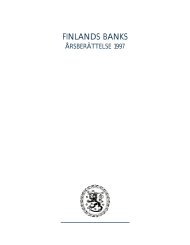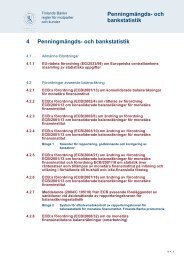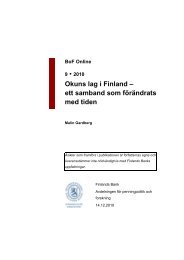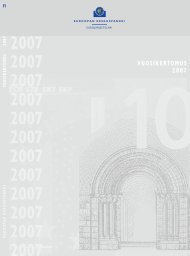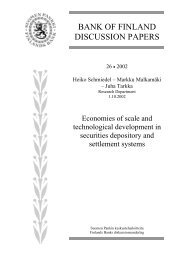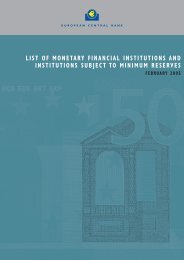Akseli Gallen-Kallela - Suomen Pankki
Akseli Gallen-Kallela - Suomen Pankki
Akseli Gallen-Kallela - Suomen Pankki
Create successful ePaper yourself
Turn your PDF publications into a flip-book with our unique Google optimized e-Paper software.
epresentation in the painting. The<br />
maiden, who in earlier sketches<br />
disappeared into the waves in<br />
many different ways, is portrayed<br />
as a pronouncedly fair and bright<br />
figure, unfolding to the viewer as<br />
an integrated whole, as coherent<br />
as possible. The artist added<br />
further intensity to Aino’s<br />
dramatic spiral pose in the 1891<br />
version by changing the position<br />
of her hands.<br />
A striking difference between<br />
the two different versions resides<br />
in the decoration of the frames.<br />
The 1889 version frames, designed<br />
by <strong>Gallen</strong>-<strong>Kallela</strong> himself, are<br />
dominated by gold-plated<br />
swastikas rising from a dark<br />
foundation. Before the ornament<br />
was adopted by the Nazis, this<br />
ancient symbol was regarded as a<br />
sign of eternity and good luck, and<br />
it has been linked with, among<br />
others, the wheel, the movement of<br />
rotation and the halo of the sun.<br />
Against the backdrop of these<br />
significances, the course of the tale<br />
from evening to morning and, as a<br />
more latent thought, the rotation<br />
of the theme – ‘the myth of the<br />
eternal return’ – receives symbolic<br />
backing from the decoration of the<br />
frame. The paddle wheel motif of<br />
the tripartite surfaces between the<br />
panels also highlights the<br />
multidimensional significances of<br />
the myth related to the cycle of<br />
life. The fully gold-plated frame in<br />
the 1891 painting represents, in<br />
turn, a more intact and delicate<br />
Finnish version, expanded by<br />
Karelian-style decorative themes<br />
and textual extracts from the<br />
Kalevala.<br />
The frame ornaments of both<br />
triptych versions originate from<br />
medieval church art, in which such<br />
decoration was used in alter<br />
screens. Religious elements merge<br />
with the world of folklore, like in<br />
the Kalevala, emphasising the<br />
artist’s view of the aspect of<br />
sacredness, which is hidden in the<br />
theme: ‘The poems of the Kalevala<br />
are so sacred for me that, when<br />
singing them, I feel like laying<br />
down my weary head to rest on a<br />
strong, solid foundation.’<br />
The difference between the<br />
paintings also emerges from<br />
changes in details related to<br />
ethnology, costumes and the boat,<br />
14


